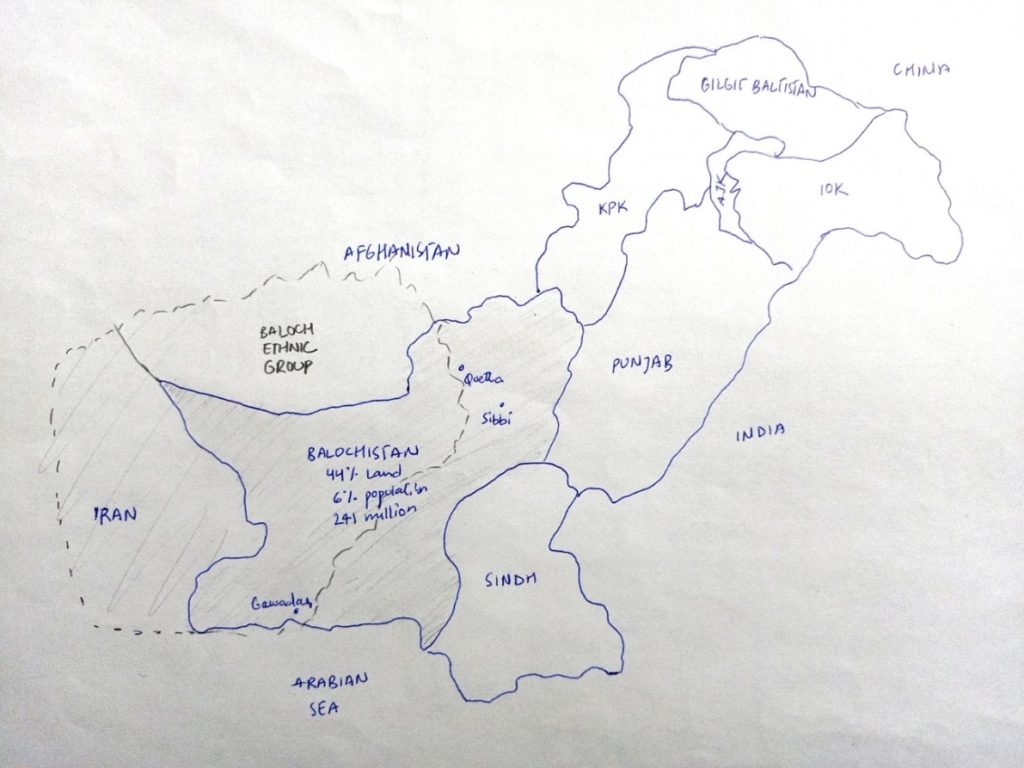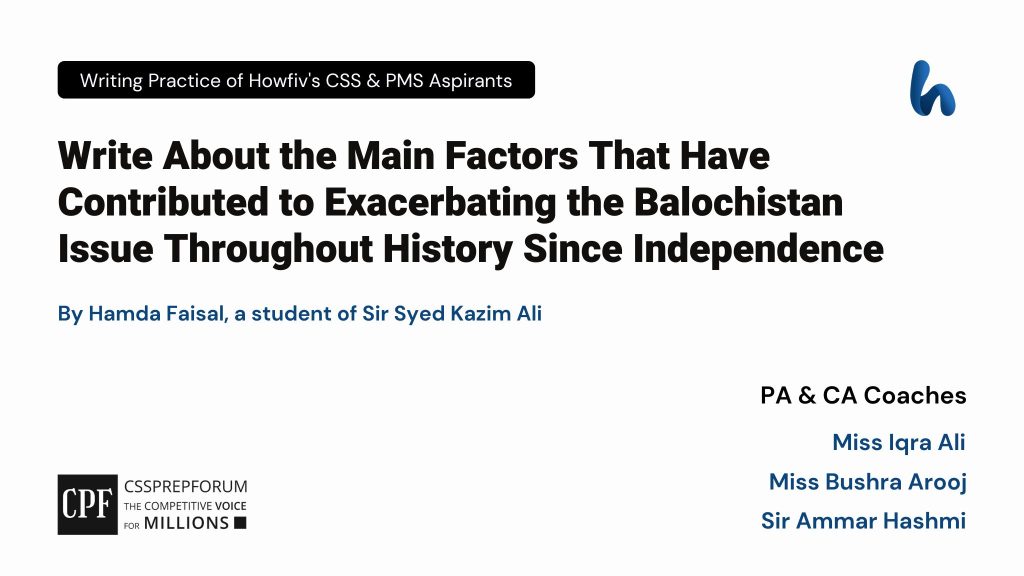CSS Current Affairs | Factors Exacerbating The Balochistan Issue
The following question of CSS Current Affairs is solved by Hamda Faisal under the supervision of Howfiv’s Pakistan Affairs and Current Affairs Coaches. She learnt how to attempt 20 marks question and essay writing from Sir Syed Kazim Ali, Pakistan’s best CSS and PMS English essay and precis teacher with the highest success rate of his students. This solved past paper question is attempted on the pattern taught by Sir to his students, scoring the highest marks in compulsory and optional subjects for years, and uploaded to help aspirants understand how to crack a topic or question, how to write relevantly, what coherence is, and how to include and connect ideas, opinions, and suggestions to score the maximum.

Outline
1-Introduction
2-Expounding the Balochistan Issue
3-Factors exacerbating the Balochistan issue since independence
- ✓Exclusion from politics
- ✓Persistence of violence and terrorism
- ✓Socio-economic underdevelopment
- ✓Abysmal education opportunities
- ✓Imperialist attitude of CPEC
- ✓Predatory state behaviour
4-Way forwards
5-Critical analysis
6-Conclusion

Answer to the Question
1-Introduction
Balochistan, located in the southwestern part of Pakistan, has around 44% of the landmass and only 6% of the country’s population. It lies at the crossroads of the South Asian region, providing a pathway to the Arabian Sea and connecting Iran, Afghanistan, and Pakistan. Hence, with its geostrategic location and resource-rich terrain, Balochistan is a centrepiece in Pakistan’s national interest. Unfortunately, several factors have led to instability and underdevelopment in the region, leading to what is now commonly referred to as the Balochistan Issue. Exclusion from politics, socio-economic underdevelopment, and the persistence of violence and terrorism are some of the factors exacerbating the Balochistan Issue, stretching back to independence. Understanding the factors is the first step towards resolution and a dream of an integrated federation in Pakistan where all the citizens can live in peace, prosperity, and harmony.
2-Expounding the Balochistan Issue
The Balochistan Issue is a state of continued insurgency breeding tensions between the people of Balochistan and the government of Pakistan. However, this discontent is not universal; a handful of extreme organisations targeting development projects are too extreme for the rest of the citizens to identify with. Taking a critical overview of the situation, the unrest can be traced back to 1948 when the state of Kalat, covering a part of today’s Balochistan, reacted against the accession to an independent Pakistan, its leaders looking forward to an integrated and unified federation, and moving on, after skirmishes in the 1960s over the establishment of the One Unit Scheme and in the 1970s over Bhutto’s dismal of the National Awami Party’s (NAP) provincial government. The Zia regime was a spell of peace and discussions for Balochistan. Still, the new century bringing in the 2006 murder of Baloch leader Nawab Akbar Khan Bugti and the Chinese companies in Gwadar has poked the Balochistan Issue again. It is characterised by separatist and non-state elements that keep the state and the provincial population at odds. Notwithstanding, a satisfactory and accepting resolution of the Balochistan issue can boost national integration and repair the distressed fabric of trust among all factors involved.

3-Factors exacerbating the Balochistan issue since the independence
Expanding the various factors exacerbating the Balochistan issue since the independence provides a holistic understanding of the issue and efficient counter-measures to resolve it for regional stability, peace and prosperity.
- ✓Exclusion from politics
The interests of the population of Balochistan are not adequately represented at the national level. It undermines and sidelines the development of the province as a whole. The main culprit is the tribal system of Balochistan; the elite who have won historically play an active role in exploiting the resources and keeping the region underdeveloped to serve their vested interests. Moreover, Bhutto removed the extremist and nationalist parties like NAP, and their extremism failed to garner large support in the region. Therefore, Balochistan suffers from the issue of proper representation, leaders who are sincere in conveying their grievances to the centre and wish to actually resolve it instead of just using it for their personal gains, as has been the case.
- ✓Persistence of violence and terrorism
Numerous organisations are aggregating the continued insurgency in the province, the most prominent being the Baloch Liberation Army (BLA) and the Baloch Liberation Front (BLF). Ever since independence, the organisations have persisted in spreading violence and terrorism in their wake, targeting major development projects like the Iran-Pakistan (IP) pipeline and CPEC routes. According to the United Nations Security Council, 26 civilians were killed in two attacks in Balochistan on 7 February 2024, the general elections day. It destabilises the region, makes development harder, and deters possible national and international ventures from coming and investing in the area. Consequently, the persistence of violence and terrorism in the region has led to underdevelopment and subpar living conditions.
- ✓Socio-economic underdevelopment
Stemming from a proper lack of political representation and widespread violence and terrorism, the Balochistan province has remained severely underdeveloped in the socio-economic sector. It perpetuates an unbreakable cycle. According to the UNDP Human Development Report 2021, Balochistan has had a growth rate of just 2.1 per cent in the last three decades. Notwithstanding, it has the highest infant and maternal mortality rate, the highest poverty rate, and the lowest literacy rate in comparison to all the other provinces of Pakistan. These indicators display the lack of opportunities for human development in Balochistan. That, in turn, adds to the growing instability and the consistent Balochistan Issue statistics.
- ✓Abysmal education opportunities
Moreover, there is a severe lack of proper and efficient educational institutions in Balochistan. The abysmal education state of a region not only fosters numerous issues but also blocks the way of mending them. According to the Pakistan Social and Living Standard Measurement (PSLM) Survey 2019-20, only 47 per cent of the population in Balochistan, 21 per cent of females and 36 per cent of males, have finished school. The province has the lower gross enrolment rate among all provinces, with the highest percentage of out-of-school children. It leaves the people devoid of sufficient opportunities to increase their standard of living, income, and development. In a nutshell, they are stuck in a circle without ever knowing a way out of it. Improving the state and quality of education is a sure way of providing the people with means to help themselves and increase the socio-economic indicators of the region.
- ✓Imperialist attitude of CPEC
Like other efforts, namely, the 18th Amendment and the NFC Award, to bring Balochistan towards growth and development, the CPEC has proved to be inefficient and slow. Though the construction of Gwadar Port started back in 2022, the promises of its yield have yet to manifest themselves. The federal government is running the project by itself and not including the Balochis in management or employment, instead relying on Chinese engineers and labourers who have faced a number of extremist and terrorist attacks. Thus, instead of improving the province’s standard of living as it has been proclaimed, the CPEC has turned into a mini-imperialistic venture where a separate colony has been established for the Chinese people working at the port, receiving salaries and reaping benefits. A change is required to re-orient the project to save it from becoming another irrelevant effort by the state.
- ✓Predatory state behaviour
Last, the state’s attitude of refusing to listen to the grievances of the people of Balochistan as a result of all the factors mentioned above and labelling the whole population of Balochistan as insurgents based on the behaviour of a few separatist and non-state actors is neither productive nor beneficial. It has refused to listen to the will of people, and it has given birth to the feeling of deprivation and restlessness in the people. Take, for instance, the recent case of Balochi’s long march steered by Mukhtar Mai to the centre and the former caretaker Prime Minister Anwar-ul-Haq Kakar refusing to address it diplomatically. It not only makes the leaders complicit in perpetuating harmful ideals, both about the true intentions of the state and the people of Balochistan in general. Therefore, where this attitude has contributed to exacerbating the issue, a change in it stands to correct the mistakes of seventy-year-old patterns of hostility and alleviate the emotional distress of the province.
4-Way forwards
To move towards peace, prosperity, and harmony, addressing and resolving the factors is vital. The authorities need to reform the structure of governance so that the efforts being made for improvement and development actually trickle down and impact the people of Balochistan. First, engaging and educating the local populace can clear the mistrust and misconception surrounding the development projects and make it less likely for them to fall for political or extremist rhetoric. Second, improving infrastructure and mode of governance can bring efficiency to the projects and provide a barrier against the traditional system of tribal lords. Following them, pouring investments and prioritising employment opportunities for locals can help the economic indicators of the region, leading towards human development and human capital. These are the optimal ways of countering extremism, exclusion, and predatory attitudes of corporations and people.
5-Critical analysis
In a robust analysis, many shortsighted efforts have made an environment conducive for non-state and anti-state actors to disrupt the peace and harmony of Balochistan, as well as Pakistan at large. On the other hand, the actions taken to counter them have proved to be fruitless, encompassing a constant attitude of using harsh means to deal with the movements and voices. As harsh means have lost their credibility and viability, even perpetuating grievances and insincerity, the ways of resolving the Balochistan issue through diplomatic talks and resolutions and improvement of socio-economic indicators should be adopted by the state in addressing the issue going further. Like the peaceful resolution of the Reko-Diq case, the benefits of a resource-rich and geostrategic area can be reaped by the locals, strengthening the centre of the federation at large.
6-Conclusion
In conclusion, many historic factors have added fuel to the fire in Balochistan, worsening the socio-economic and political health of the province. Though there are more factors than the ones mentioned above, like ethnic conflict, they stem from the primary causes of the issue mentioned above—like exclusion from politics and hindered socio-economic growth, leading towards violence and predatory attitudes. It is imperative to identify the patterns that have been repeating since independence to properly grasp the base of the Balochistan issue and thus devise suitable counter-measures to resolve them. The people of Balochistan are deserving of their constitutional rights and the benefits of the resources of their region. Resolving these factors will collectively enhance the prospects of the whole country.

CSS Solved Past Papers’ Essays
Looking for the last ten years of CSS and PMS Solved Essays and want to know how Sir Kazim’s students write and score the highest marks in the essays’ papers? Then, click on the CSS Solved Essays to start reading them.
CSS Solved Essays
CSS Solved General Science & Ability Past Papers
Want to read the last ten years’ General Science & Ability Solved Past Papers to learn how to attempt them and to score high? Let’s click on the link below to read them all freely. All past papers have been solved by Miss Iqra Ali & Dr Nishat Baloch, Pakistan’s top CSS GSA coach having the highest score of their students.
General Science & Ability Solved Past Papers












